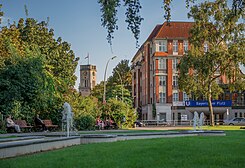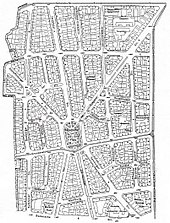Bayerischer Platz
| Bayerischer Platz | |
|---|---|
| Place in Berlin | |
 Bayerischer Platz ( Schöneberg Town Hall in the background) |
|
| Basic data | |
| place | Berlin |
| District | Schöneberg |
| Created | 1908 |
| Newly designed | 1958 |
| Confluent streets |
Grunewaldstrasse , Innsbrucker Strasse , Salzburger Strasse , Landshuter Strasse , Westarpstrasse , Aschaffenburger Strasse , Meraner Strasse |
| use | |
| User groups | Pedestrians , cyclists , road traffic , public transport |
| Space design | Fritz Enke, Karl-Heinz Tümler |
The Bavarian Square is a town square in the center of the Bavarian quarter in Berlin district of Schoeneberg the district Tempelhof-Schöneberg . The Landshuter, the Westarp, the Salzburg, the Innsbruck, the Meraner and the Aschaffenburger Straße flow onto it. The Grunewaldstrasse crosses it.
history
The place was after the first development plans the name space Y . On the decision of the Schöneberger Magistrate it was named Bayrischer Platz . The name is reminiscent of what was then the Kingdom of Bavaria , today's Free State of Bavaria , and was the center of a whole district with Bavarian street names. In 1908 it was designed according to plans by Fritz Encke as a decorative square with green spaces, trees, hedges, a large fountain and wooden benches. The water oasis consisted of a large stone basin, the circle of which was formed by corners and bulges. The edge of the pool was about three feet high and covered with granite. In the middle of the basin, a fountain, the nozzle of which was embedded in a designed flower head, raised the water about ten meters. In 1909 the spelling was changed to Bayerischer Platz . The perimeter development was built between 1900 and 1914 according to plans by the Berlinische Bodengesellschaft in the style of the late Wilhelminian era .
Bombardments and firestorms of the Second World War devastated the green area of the square and destroyed large parts of the peripheral buildings. In February 1945, three aerial bombs hit the underground station while two trains stopped there. 63 people died. After the rubble had been cleared , there was only a newspaper kiosk in the square.
Since the route of Grunewaldstrasse was straightened in 1956, the street has crossed the square. The green area on the central island was given a new look in 1958 according to plans by Karl-Heinz Tümler with four fountains in artificial stone basins . The underground station received a glass pavilion structure in the style of the time. The gaps in the perimeter development were closed between 1956 and 1958. The underground pavilion was demolished in 1967 and replaced by the current structure in 1971.
remodeling
In 2007, residents and tradespeople joined forces to form the Quartier Bayerischer Platz initiative , which aims to improve the quality of stay in the area. Traders, the former Berlin Senator for Finance Annette Fugmann-Heesing and many other people came together to participate, including the architect couple Andrea and Wilfried van der Bel. They created a model free of charge that also took residents' suggestions into account. This enabled the administration of the BVG to participate, because they wanted to renovate the underground station anyway. The bunker-like subway entrances are now visually loosened up by an attached multi-purpose pavilion. The structure, made of steel and glass, will be upgraded with a Kiezcafé, a permanent exhibition on the history of the Jews from the Bavarian Quarter and a multi-purpose room. The BVG is financing the renovation with 2.3 million euros. The demolition of the subway entrances has already started and should be completed before winter 2013/2014. The second quarter of 2014 is named as the date for the completion of the station with roof terrace .
Subway station

The underground station of the same name went into operation in December 1910 , initially with the Schöneberg subway (today: Line U4 ) between Nollendorfplatz in the north and Innsbrucker Platz in the south. The U7 line has also been crossing here since 1971, making it possible to travel to Spandau , Charlottenburg and Neukölln .
Cultural environment
Many artists and intellectuals lived on the square and its immediate surroundings. Erich Fromm lived at Bayerischer Platz 1 . A few steps away at Bozener Strasse 20 Gottfried Benn , at Bozener Strasse 18 Eduard Bernstein and at Stübbenstrasse 5 Arno Holz . Even Albert Einstein was in the home setting. The Jewish intellectual Benedict Lachmann founded the bookshop Bayerischer Platz in 1919 . Because many of the former residents were of Jewish origin and were expelled or even killed during the Nazi era , there have been places of remembrance around the square since 1993 . This area monument has 80 signs on street lamps that reproduce anti-Jewish regulations as copies. There is a memorial to the destroyed synagogue on the premises of the Löcknitz School in the vicinity of the square . Thanks to the involvement of the BVG, all of the memorial sites are now presented in an even more concentrated manner to posterity in the above-mentioned permanent exhibition in the underground pavilion.
See also
Web links
- Bayerischer Platz. In: Street name lexicon of the Luisenstädtischer Bildungsverein (near Kaupert )
- History of the Bayerischer Platz with historical photos
Individual evidence
- ↑ Hans-Werner Klünner (ed.): Berlin places. Photographs by Max Missmann . Nicolai, Berlin 1996, ISBN 3-87584-610-9 , p. 107. Illustration of the square from 1909.
- ↑ a b Sebastian Höhn: Train station with roof terrace. In: Berliner Zeitung , September 19, 2013
Coordinates: 52 ° 29 ′ 20.4 " N , 13 ° 20 ′ 23.5" E
